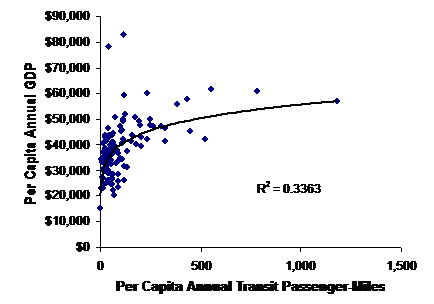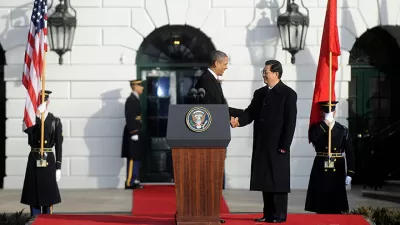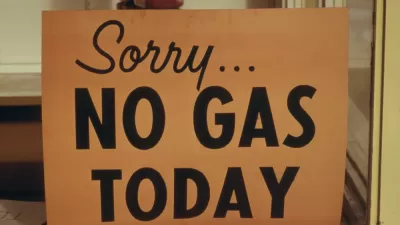Here is good news for anybody looking for smart ways to reduce climate change. "Win-Win" transportation emission reduction strategies can provide substantial energy conservation and emission reductions in ways that also help achieve economic and social objectives.
Here is good news for anybody looking for smart ways to reduce climate change. "Win-Win" transportation emission reduction strategies can provide substantial energy conservation and emission reductions in ways that also help achieve economic and social objectives.
Why Transportation?
When it comes to reducing transportation emissions, transportation is special because it has so many impacts on people and the economy. Inefficient motor vehicle traffic imposes significant costs on society, including traffic congestion, road and parking facility costs, consumer costs, accident damages, energy costs and pollution damages. Smart transportation policy reforms reduce these costs by increasing overall transportation system efficiency. These strategies improve travel options, apply efficient pricing, and reduce planning distortions. Implemented to the degree justified for economic efficiency, these strategies also reduce climate emissions by 30-50% compared with what would otherwise occur.
Described differently, Win-Win transportation emission reduction strategies provide substantial co-benefits, including congestion reductions, infrastructure cost savings, consumer savings, traffic safety, improved mobility for non-drivers, more livable communities, reduced local pollution, and improved public fitness and health, and so can provide substantial emission reductions in ways that also support economic development and social equity. These are no-regret strategies that are justified regardless of any uncertainty about climate change risks.
Here are examples of Win-Win strategies and their typical VMT reduction impacts:
Pay-As-You-Drive insurance and registration fees (8-10%)
Efficient parking pricing and cash out (6-10%)
Efficient road pricing (3-6%)
Mobility Management programs (4-8%)
Transit & ridesharing priority (3-9%)
Walking & cycling improvements (2-6%)
Smart growth planning reforms (4-12%)
Freight transport management (0.5-2%)
Carsharing (1-2%)
Tax shifting (5-15%)
A Paradigm Shift
Conventional planning tends to be reductionist: each profession or agency tends to focus on a narrowly defined problem. For example, transportation agencies focus on traffic congestion reduction, public safety agencies focus on reducing crashes, and environmental agencies focus on emission reductions. This approach can lead to the implementation of policies that help solve one problem but exacerbate others, and tends to undervalue strategies that provide multiple benefits.
Efficient transportation requires more comprehensive and integrated planning, which considers indirect and external impacts, and so identifies the policies that provide the greatest total benefits to society. Considering all benefits and costs, Win-Win strategies are often the best way to reduce transportation emissions.
Consumer Benefits (Live Long and Prosper)
Win-Win transportation solutions benefit consumers directly by improving transportation options (better walking and cycling conditions, better public transport and taxi services, and innovations such as carsharing, telework and delivery services), providing new opportunities to save money, and creating more accessible, less automobile-dependent communities.
With current practices, consumers pay for road and parking facilities indirectly, through general taxes and bundled with building rents, regardless of how much they drive. Current insurance pricing is inefficient and unfair because most premiums give far too little weight to annual mileage. More efficient road, parking, insurance and fuel pricing rewards consumers when they reduce their vehicle travel and associated costs, providing savings and increased affordability.
Win-Win strategies can help solve difficult problems and provide additional, indirect consumer benefits. For example, more efficient parking management can significantly reduce the costs of building homes in accessible locations, providing true affordability by reducing both housing and transportation costs. Reducing automobile traffic in a community substantially reduces traffic casualty rates. Improved walking and cycling conditions provides substantial health benefits.
Supporting Economic Development
By increasing transportation system efficiency, Win-Win strategies increase economic productivity and support economic development. They do this by reducing inefficiencies such as traffic congestion, road and parking infrastructure costs, accident and pollution damages, and the cost burden of importing petroleum to fuel vehicles.
Per Capita GDP and Transit Ridership

GDP tends to increase with per capita transit travel. (Each dot is a U.S. urban region.)
Recent research shows that per capita economic productivity tends to increase as public transit travel and land use density increases in a community, and declines as per capita motor vehicle travel and roadway supply increases. This reflects transportation cost savings and agglomeration efficiencies from more efficient transport and land use policies. These two graphs, unfortunately not very clear, indicate these relationships. You'll find much better images and more detailed information in the reports.
Per Capita GDP and VMT For U.S. States

Per capita economic productivity increases as vehicle travel declines. (Each dot is a U.S. state.)
This is basic economics: increased efficiency increases productivity. Fortunately, it also reduces pollution emissions. That's good news from here to Copenhagen.
For more information:
"Win-Win Transportation Emission Reduction Strategies" (www.vtpi.org/wwclimate.pdf )
"Smart Transportation Emission Reduction Strategies" (www.vtpi.org/ster.pdf )"Are Vehicle Travel Reduction Targets Justified? Evaluating Mobility Management Policy Objectives Such As Targets To Reduce VMT And Increase Use Of Alternative Modes" (www.vtpi.org/vmt_red.pdf )
"Moving Cooler: Transportation Strategies to Reduce Greenhouse Gas Emissions" (www.movingcooler.info)
"Evaluating Transportation Economic Development Impacts" (www.vtpi.org/econ_dev.pdf )
"Drive Less, Pay Less: Environmental and Transportation Groups Unveil Performance Standard for Pay-As-You-Drive Auto Insurance" (http://www.ceres.org/Page.aspx?pid=1157 )
"Online TDM Encyclopedia" (www.vtpi.org/tdm)

Maui's Vacation Rental Debate Turns Ugly
Verbal attacks, misinformation campaigns and fistfights plague a high-stakes debate to convert thousands of vacation rentals into long-term housing.

Planetizen Federal Action Tracker
A weekly monitor of how Trump’s orders and actions are impacting planners and planning in America.

In Urban Planning, AI Prompting Could be the New Design Thinking
Creativity has long been key to great urban design. What if we see AI as our new creative partner?

Massachusetts Budget Helps Close MBTA Budget Gap
The budget signed by Gov. Maura Healey includes $470 million in MBTA funding for the next fiscal year.

Milwaukee Launches Vision Zero Plan
Seven years after the city signed its Complete Streets Policy, the city is doubling down on its efforts to eliminate traffic deaths.

Portland Raises Parking Fees to Pay for Street Maintenance
The city is struggling to bridge a massive budget gap at the Bureau of Transportation, which largely depleted its reserves during the Civd-19 pandemic.
Urban Design for Planners 1: Software Tools
This six-course series explores essential urban design concepts using open source software and equips planners with the tools they need to participate fully in the urban design process.
Planning for Universal Design
Learn the tools for implementing Universal Design in planning regulations.
Gallatin County Department of Planning & Community Development
Heyer Gruel & Associates PA
JM Goldson LLC
City of Camden Redevelopment Agency
City of Astoria
Transportation Research & Education Center (TREC) at Portland State University
Jefferson Parish Government
Camden Redevelopment Agency
City of Claremont





























